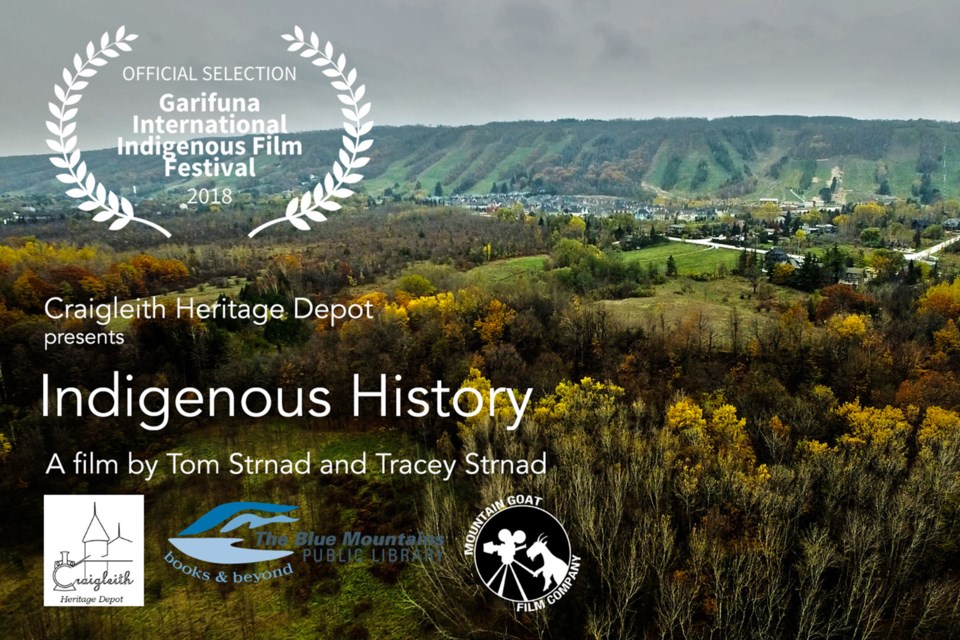A short film about the indigenous history of Craigleith has been selected for an international film festival this spring.
The film, called Indigenous History was commissioned by The Town of The Blue Mountains Museum Advisory Council and created by Blue Mountains-based filmmakers Mountain Goat Film Company. It gives a brief introduction to the Wyandot Nation ancestors known as the Petun, and the historical evidence of them settling in the area now known as Craigleith.
The short film will be shown at the Garifuna International Indigenous Film Festival in Santa Monica, Calif., May 18-27, 2018.
The film was one of three in a series, the two others featured the ski and apple industries in The Blue Mountains.
The goal behind the films was education and developing interest in the local history with the idea of drawing people in to the local museum and library to learn more.
“The Petun represent the earliest human occupation here in The Blue Mountains,” said Craigleith Heritage Depot Museum curator Andrea Wilson. “We wanted to have that first key part to give people the sense of depth and breadth of human occupation in The Blue Mountains.”
She said she’s seen a lot of excitement around the film and its success. In particular it’s generated pride in the community.
“It shows this constant movement of people has happened for thousands of years and we’re all connected by a real appreciation of this place,” said Wilson. “In the case of the Wyandot of Kansas, this is part of their memory bank.”
Chief Jan English of the Wyandot Nation of Kansas has visited Craigleith in the past. Her tribe is descended from the Petun who settled in Craigleith for the summers. She is interviewed in the film.
"The film represented a homecoming voyage of rediscovery and appreciation," said English. "In our hearts and souls, the lure of the homeland lingers."
"We appreciate and are grateful for being included in the Indigenous Film process. It is our hope that the our stories of long ago, like those of other Indigenous communities, may reach others who are today seeking to paths that they hope will lead to encouragement, resilience, healing, and strengthening of those individuals and communities affected by the forced removal of Diaspora."
Beyond the strong reception of the film, Wilson said she’s noticed an encouraging amount of engagement with the museum and a renewed desire by people to know more about local history.
“We have a lot of material here we want people to access,” she said. “This has been a really good point of entry for people to discover more.”
The film was written, directed, produced and edited by Tom and Tracey Strnad.
“As filmmakers based in The Blue Mountains, it is extremely important to tell our local stories and celebrate the historical importance that this area plays in all three areas explored in this series: Indigenous History, The Apple Industry and The Ski Industry,” said Tom. “Tracey and I are thrilled and honoured to have the Indigenous History film chosen for the Garifuna International Indigenous Film Festival in Los Angeles.”
He said the research for Indigenous History was eye-opening for him and Tracey. They studied the research into the Plater-Martin and Plater-Fleming sites located in Craigleith, and the records of what happened over 10,000 years ago when the Petun people first arrived to the locations and started farming.
“What Tracey and I learned in researching this segment… transformed our views on the history of the area and how important preserving these sites are for future generations,” said Tom.
He and Tracey were honoured to help tell the story of the Wyandot Nation of Kansas.
“By helping to tell (Chief Jan English's) story and the story of the Wyandot Nation arriving to what is now Craigleith, that is the true reward for us as filmmakers,” said Tom.
The films are available to borrow from The Blue Mountains Public Library.
According to Wilson, this is the beginning of the town’s venture into educational films. Next year, the museum council will commission two virtual reality films. The films will use VR technology to allow a viewer to dive deep into Georgian Bay to explore the wreck of the Mary Ward, and to walk the path at Scenic Caves that leads to the Village of the Souls.
Click here for a trailer of all three films in The Blue Mountains’ educational film series.



